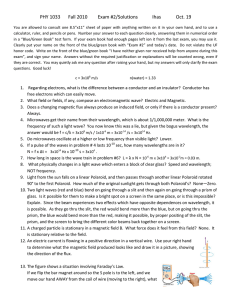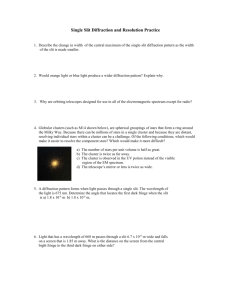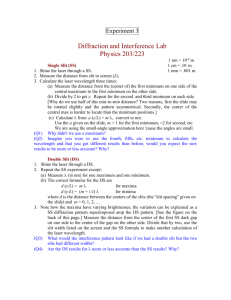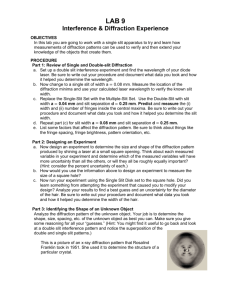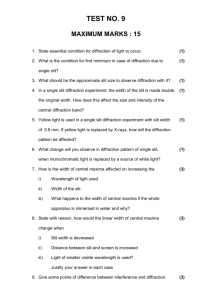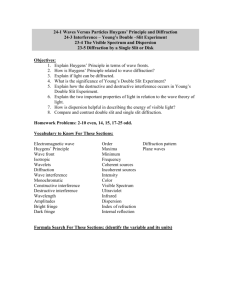Optics - icbsexiiphysics
advertisement
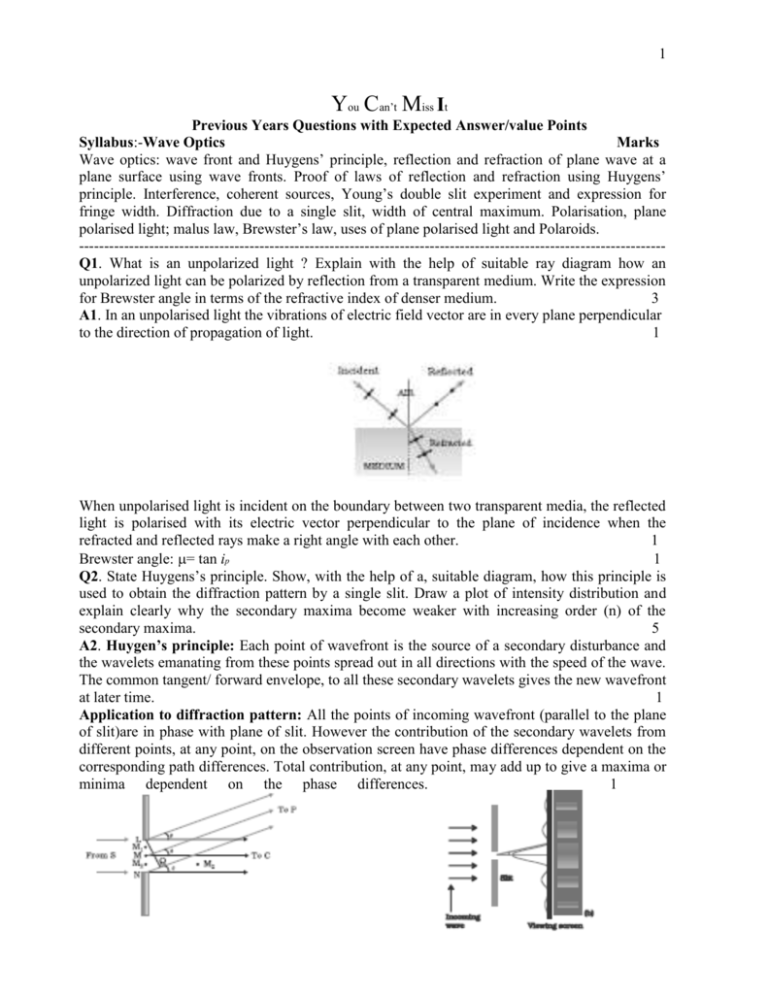
1 You Can’t Miss It Previous Years Questions with Expected Answer/value Points Syllabus:-Wave Optics Marks Wave optics: wave front and Huygens’ principle, reflection and refraction of plane wave at a plane surface using wave fronts. Proof of laws of reflection and refraction using Huygens’ principle. Interference, coherent sources, Young’s double slit experiment and expression for fringe width. Diffraction due to a single slit, width of central maximum. Polarisation, plane polarised light; malus law, Brewster’s law, uses of plane polarised light and Polaroids. --------------------------------------------------------------------------------------------------------------------Q1. What is an unpolarized light ? Explain with the help of suitable ray diagram how an unpolarized light can be polarized by reflection from a transparent medium. Write the expression for Brewster angle in terms of the refractive index of denser medium. 3 A1. In an unpolarised light the vibrations of electric field vector are in every plane perpendicular to the direction of propagation of light. 1 When unpolarised light is incident on the boundary between two transparent media, the reflected light is polarised with its electric vector perpendicular to the plane of incidence when the refracted and reflected rays make a right angle with each other. 1 Brewster angle: = tan ip 1 Q2. State Huygens’s principle. Show, with the help of a, suitable diagram, how this principle is used to obtain the diffraction pattern by a single slit. Draw a plot of intensity distribution and explain clearly why the secondary maxima become weaker with increasing order (n) of the secondary maxima. 5 A2. Huygen’s principle: Each point of wavefront is the source of a secondary disturbance and the wavelets emanating from these points spread out in all directions with the speed of the wave. The common tangent/ forward envelope, to all these secondary wavelets gives the new wavefront at later time. 1 Application to diffraction pattern: All the points of incoming wavefront (parallel to the plane of slit)are in phase with plane of slit. However the contribution of the secondary wavelets from different points, at any point, on the observation screen have phase differences dependent on the corresponding path differences. Total contribution, at any point, may add up to give a maxima or minima dependent on the phase differences. 1 2 The central point is a maxima as the contribution of all secondary wavelet pairs are in phase here. Consider next a point on the screen where an angle = 3/2a. Divide the slit into three equal parts. Here the first two-thirds of the slit can be divided into two halves which have a 2 path difference. The contributions of these two halves cancel. Only the remaining one-third of the slit contributes to the intensity at a point between the two minima. Hence, this will be much weaker than the central maximum (where the entire slit contributes in phase). We can similarly show that there are maxima at =(n + 1/2) /a with n = 2, 3, etc. These become weaker with increasing n, since only one fifth, one-seventh, etc., of the slit contributes in these cases. 1 Q3. In Young’s double slit experiment, the two slits 0.15 mm apart are illuminated by monochromatic light of wavelength 450 nm. The screen is 1.0 m away from the slits. (a) Find the distance of the second (i) bright fringe, (ii) dark fringe from the central maximum. (b) How will the fringe pattern change if the screen is moved away from the slits ? 3 A3. Q4. How does an unpolarised light get polarised when passed through a polaroid? Two polaroids are set in crossed positions. A third polaroid is placed between the two making an angle with the pass axis of the first polaroid. Write the expression for the intensity of light transmitted from the second polaroid. In what orientations will the transmitted intensity be (i) minimum and (ii) maximum ? 3 A4. A polaroid consists of long chain molecules aligned in a particular direction. The electric vectors (associated with the propagating light wave) along the direction of the aligned molecules get absorbed. Thus, if an unpolarised light wave is incident on such a polaroid, then the light wave will get linearly polarised with the electric vector oscillating along a direction perpendicular to the aligned molecules. 1 (Give full credit if student explains it through a diagram) Expression for the intensity transmitted through second Polaroid : where I0 is the intensity of the polarized light after passing through the first polaroid. 3 Intensity will be maximum when = 45° and minimum when = 0° ½+½ Q5. Describe Young's double slit experiment to produce interference pattern due to a monochromatic source of light. Deduce the expression for the fringe width. 3 OR Use Huygen's principle to verify the laws of refraction. A5. 4 Q6. (a) Describe briefly, with the help of suitable diagram, how the transverse nature of light can be demonstrated by the phenomenon of polarization. 3 (b) When unpolarized light passes from air to a transparent medium, under what condition does the reflected light get polarized ? A6. 5 Q7. State the importance of coherent sources in the phenomenon of interference. In Young's double slit experiment to produce interference pattern, obtain the conditions for constructive and destructive interference. Hence deduce the expression for the fringe width. How does the fringe width get affected, if the entire experimental apparatus of Young is immersed in water ? 5 OR (a) State Huygens' principle. Using this principle explain how a diffraction pattern is obtained on a screen due to a narrow slit on which a narrow beam coming from a monochromatic source of light is incident normally. (b) Show that the angular width of the first diffraction fringe is half of that of the central fringe. (c) If a monochromatic source of light is replaced by white light, what change would you observe in the diffraction pattern ? 5 A7. 6 7 OR 8 9 Q8. 2 A8. 10 Q9. 5 11 12 Q Q15. 2 A15. Q16. 13 3 A16. 14 Q17. Q18. 3 15 A18. Q19. 3 16 A19.

